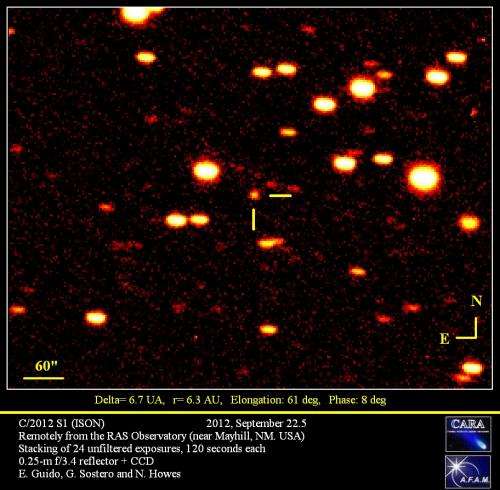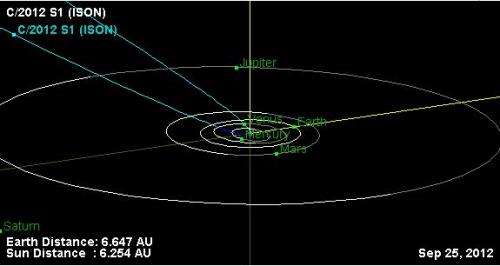New 'Sun-skirting' comet could provide dazzling display in 2013

2013 is looking to be a promising year for potential naked-eye comets, as a new comet has been discovered that will likely skirt close to the Sun, and could provide a stunning display late next year. The comet, named Comet C/2012 S1 (ISON), as it was discovered by a Russian team at the International Scientific Optical Network (ISON), is currently about the distance of Jupiter's orbit. But it is projected to come within less than 2 million km from the Sun at perihelion by November 28, 2013. Ernesto Guido and Giovanni Sostero from the Remanzacco Observatory in Italy, along with their colleague Nick Howes from the UK have imaged the comet with the RAS telescope in New Mexico, and say, "According to its orbit, this comet might become a naked-eye object in the period November 2013 – January 2014. And it might reach a negative magnitude at the end of November 2013."
This new comet joins Comet C/2011 L4 PanSTARRS, which is projected to come within 45 million kilometers (28 million miles) of the Sun on March 9, 2013, which is close enough for quite a bit of cometary ice to vaporize and form a bright coma and tail. Comet PanSTARRS will be visible at perihelion to southern hemisphere, while Comet ISON should be visible to mid-latitude northern hemisphere skywatchers, according to the Remanzacco team.
Right now, Comet ISON is at magnitude +18, and only larger telescopes can see it. How bright will the comet get, and could it even be visible during daytime? That's the big question which only time will answer. Just 2 million km distant from the Sun is incredibly close, and if the comet stays intact, it could reach a brilliant negative magnitude of between -11 and -16. Comparatively, the full Moon is about magnitude -12.7.

But this will happen only if the comet will stay together. Comets can be fairly unpredictable, and other comets that have come that close to the Sun—such as Comet Elenin in 2011, Comet LINEAR in 1999 and Comet Kohoutek in 1973—failed to live up to expectations of brightness and visibility.
But other comets have survived, like Comet Lovejoy earlier this year, which came two times closer, and Comet McNaught in 2007 which became visible even in daylight when it reached magnitude -5.5. It was not as close to the Sun as Comet ISON will be, however, as McNaught was about 24 million km away.
The discovery of C/2012 S1 (ISON) was made by Vitali Nevski, of Vitebsk, Belarus, and Artyom Novichonok, of Kondopoga, Russia with a 0.4-meter reflecting telescope near Kislovodsk, Russia.
You can see the ephermides of the Comet ISON here, from the Minor Planet Center.
Source: Universe Today


















